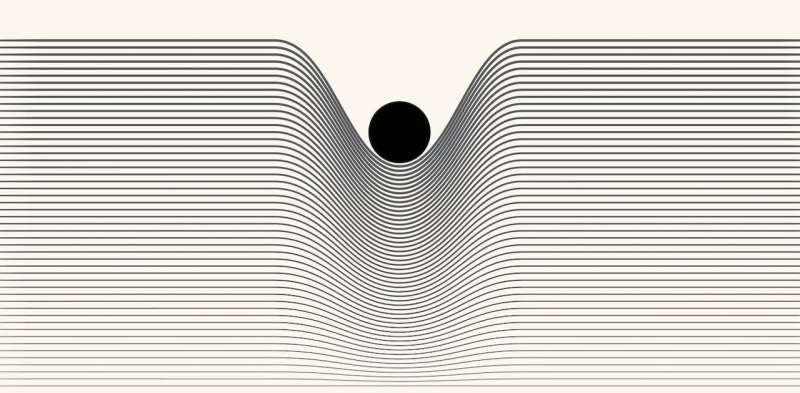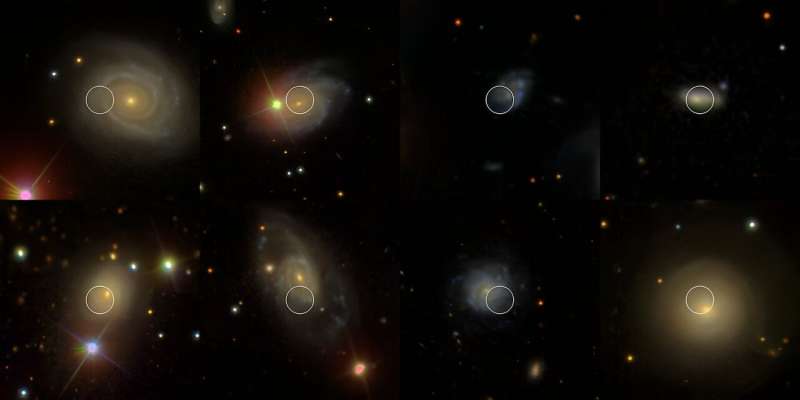
Einstein’s theory of gravity general relativity has been very successful for more than a century. However, it has theoretical shortcomings. This is not surprising: the theory predicts its own failure at spacetime singularities inside black holes and the Big Bang itself.
Unlike physical theories that describe the other three fundamental forces of physics, the electromagnetic and the strong and weak nuclear interactions, general relativity has only been tested in weak gravity.
The deviations of gravity from general relativity are by no means ruled out or tested anywhere in the universe. And according to theoretical physicists, deviation must happen.
Deviations and quantum mechanics
According to Einstein, our universe originated in a Big Bang. Other singularities hide inside black holes: space and time cease to matter there, while quantities such as energy density and pressure become infinite. These signal that Einstein’s theory fails there and must be replaced by a more fundamental one.
Naively, spacetime singularities should be resolved by quantum mechanics, which applies at very small scales.
Quantum physics relies on two simple ideas: point particles make no sense; and the Heisenberg Uncertainty Principle, which states that one can never know the value of certain pairs of quantities with absolute precision, for example the position and velocity of a particle. This is because particles should not be thought of as points, but as waves; on small scales they behave like waves of matter.
This is enough to understand that a theory that includes both general relativity and quantum physics should be free of such pathologies. However, any attempt to mix general relativity and quantum physics necessarily introduces deviations from Einstein’s theory.
Therefore, Einstein’s theory of gravity cannot be the ultimate theory of gravity. Indeed, it was not long after Einstein’s introduction of general relativity in 1915 that Arthur Eddington, best known for verifying this theory in the 1919 solar eclipse, began to look for alternatives just to see how things could be different.
Einstein’s theory has survived all tests to date and has accurately predicted various results from the precession of Mercury’s orbit to the existence of gravitational waves. So where are these deviations from general relativity hiding?
Cosmology matters
A century of research has given us the standard model of cosmology known as the -Cold Dark Matter (CDM) model. Here stands for either Einstein’s famous cosmological constant or a mysterious dark energy with similar properties.
Dark energy was introduced ad hoc by astronomers to explain the acceleration of cosmic expansion. Despite fitting cosmological data extremely well until recently, the CDM model is spectacularly incomplete and unsatisfactory from a theoretical point of view.
In the last five years, it has also faced severe observational tensions. The Hubble constant, which determines the age and distance scale of the universe, can be measured in the early universe using the cosmic microwave background and in the late universe using supernovae as standard light.
These two measurements give inconsistent results. More importantly, the nature of the main ingredients of the CDM model dark energy, dark matter, and the field driving early universe inflation (a very short period of extremely rapid expansion originating from the seeds of galaxies and galaxy clusters) remains a mystery.
From an observational point of view, the most compelling motivation for modified gravity is the acceleration of the universe discovered in 1998 with Type Ia supernovae, whose luminosity is dampened by this acceleration. The CDM model based on general relativity postulates an extremely exotic dark energy with negative pressure that permeates the universe.
The problem is that this dark energy has no physical basis. Its nature is completely unknown, although a host of models have been proposed. The proposed alternative to dark energy is a cosmological constant, which, according to quantum mechanical back-of-the-envelope calculations (however questionable), should be huge.
However, must instead be incredibly fine-tuned to a tiny value to fit the cosmological observations. If dark energy exists, our ignorance of its nature is deeply troubling.
Alternatives to Einstein’s theory
Could it be that problems instead arise from wrongly trying to fit the cosmological observations into general relativity, like fitting a person into a pair of pants that are too small? That we observe the first deviations from general relativity, while the mysterious dark energy simply does not exist?

This idea, first proposed by researchers at the University of Naples, has gained enormous popularity, while the warring dark energy camp remains energized.
How can we tell? Deviations from Einstein’s gravity are constrained by solar system experiments, recent observations of gravitational waves, and the images of near-horizon black holes.
There is now a large literature on theories of gravity alternative to general relativity dating back to Eddington’s early studies from 1923. A very popular class of alternatives is the so-called scalar-tensor gravity. It is conceptually very simple, as it introduces only one additional ingredient (a scalar field corresponding to the simplest, spinless, particle) to Einstein’s geometric description of gravity.
However, the consequences of this program are far from trivial. A striking phenomenon is the “chameleon effect”, which consists of the fact that these theories can masquerade as general relativity in high-density environments (such as in stars or in the solar system), while strongly deviating from it in the low-density environment of cosmology .
As a result, the extra (gravity) field is effectively absent in the first type of systems, which disguises itself as a chameleon does, and is felt only on the largest (cosmological) scales.
The current situation
Today, the range of alternatives to Einstein’s gravity has expanded dramatically. Even adding a single massive scalar excitation (namely a spin-zero particle) to Einstein’s gravity and keeping the resulting equations “simple” to avoid some known fatal instabilities has resulted in the much broader class of Horndeski theories and subsequent generalizations.
Theorists have spent the last decade extracting physical consequences from these theories. Recent detections of gravitational waves have provided a way to limit the physical class of modifications of Einstein’s gravity allowed.
However, much work remains to be done with the hope that future advances in multi-messenger astronomy will lead to the discovery of modifications of general relativity in which gravity is extremely strong.
Provided by The Conversation
This article is republished from The Conversation under a Creative Commons license. Read the original article.![]()
Citation: Why Einstein Must Be Wrong: In Search of the Theory of Gravity (2023, September 25) Retrieved September 26, 2023, from https://phys.org/news/2023-09-einstein-wrong-theory-gravity.html
This document is subject to copyright. Except for any fair dealing for the purpose of private study or research, no part may be reproduced without written permission. The content is provided for informational purposes only.
#Einstein #wrong #search #theory #gravity
Image Source : phys.org